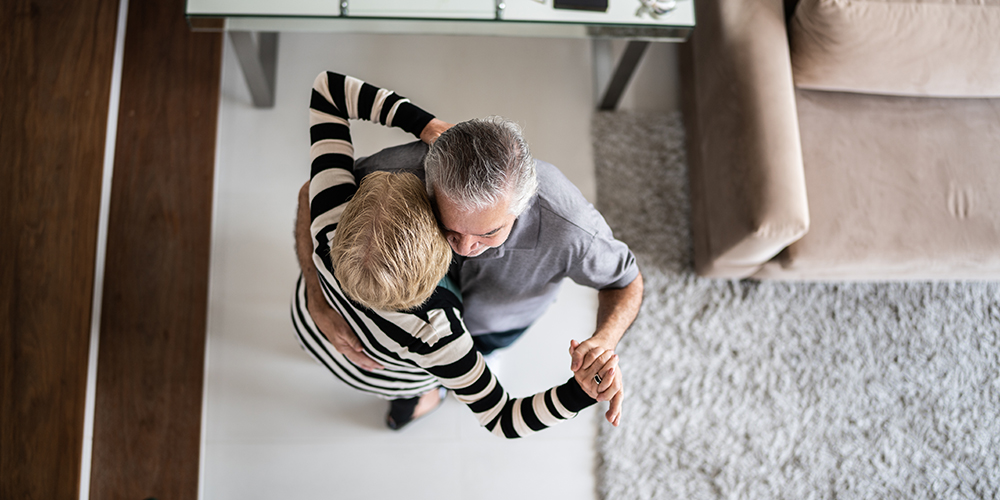Close your eyes and just dance.
Text: Anika Zielenski
Can sports and movement prevent cancer? Or support treatment? If so, then why? Five facts from the fields of sports medicine and basic research.
1. Even mild physical activity can reduce the risk of cancer.
Sports and movement can be highly effective in preventing some forms of cancer. Regular exercise most dramatically impacts the risk of developing tumors of the bowels, colorectal cancer in particular, as well as breast cancer.
The goal is not to strain the body by exhaustive strenuous exercise such as high-intensity interval training. Even normal, daily activities can be enough. Sports medicine physician Henner Hanssen recommends, for instance, that patients with these types of cancer take a brisk, hour-long walk each day, five to seven days a week. Depending on the study cited, this can reduce cancer mortality by up to 50 percent.
There are different reasons why sports and movement influence cancer risk. For example, regular physical activity lowers the body fat percentage and the concentration of inflammatory signaling molecules secreted by fatty tissue in the body. Movement also stimulates the bowels, enabling food to be digested more quickly, leading to shorter transit times in the digestive tract. This is yet another mechanism that reduces the risk of colorectal cancer in particular, directly from the onset of disease as a means of primary prevention.
2. Muscles detoxify the body.
Do movement and sports help even if patients already have cancer? Molecular biologist Christoph Handschin studies this question in mice. He explains: “The tumor changes the whole metabolism. It’s made up of cells that want to keep growing and growing. And to do that, they need energy. So, the tumor stimulates other tissues to provide this energy. That causes the body to rapidly break down fat and muscle. This increases blood lipids, and the blood plasma becomes very cloudy.”
Yet when sick mice run on a treadmill every day, their blood plasma returns to normal. “Muscles detoxify our bodies to a certain extent. Training not only helps the muscles to function more effectively; it also normalizes the metabolism,” says Handschin.
3. Sports and movement can improve quality of life in patients with cancer.
Physical activity not only helps mice. It has positive effects on cancer and cancer-related symptoms in people, too. Physical activity can:
- function as an antidepressant
- reduce fatigue
- combat muscle atrophy
- improve chemotherapy tolerance
- reduce mortality for stomach and bowel cancer by up to 50 percent
Yet even regular training cannot cure cancer outright. “It’s important to be very clear on this point,” says Hanssen. “You cannot cure a pre-existing cancer with sports and exercise or lifestyle changes alone. Yet, exercise can serve as a complementary treatment. But chemotherapy must of course remain the primary treatment method.”
4. Why movement helps sick patients is a question that remains largely unresearched.
For cancer patients, engaging in physical activity can have many positive effects. By why? “Until now, that hasn’t been subject to much research on the molecular level,” comments Handschin, who conducts basic research of his own. “Most sports studies used to concentrate on the subjective experiences of the patients, not the mechanisms involved.” In addition, biomedical cancer research focuses largely on fighting the tumor itself rather than combating the symptoms it causes, such as muscle atrophy or fatigue. As a result, there are currently no medications able to produce effects similar to those that sports and movement have on the well-being of patients with cancer.
5. Moderate exercise is possible during cancer treatment.
Even though researchers do not know exactly why it helps, the benefits of so-called movement therapy are scientifically proven. At first glance, exercising while battling a severe illness seems counterintuitive. The intense side effects caused by radiation or chemotherapy can also limit a patient's ability to engage in physical activities. According to Hanssen, mild strength and cardiovascular training are both possible and advisable at appropriate intervals and in the recovery phases following or in between treatment cycles as an adjunct approach.
“The first step is always the hardest,” says Hanssen. “Nausea, vomiting and dizziness are typical symptoms of cancer therapy. The good news is that the benefits of regular movement therapy – including increased strength, fitness and vitality – can start to set in after few weeks.”
Movement therapy focuses exclusively on moderate exercise during which participants may work up a light sweat but are still able to carry on a conversation. Hanssen recommends activities such as jogging, swimming, cycling, Nordic walking or even dancing: “Anything that suits the lifestyle of the patient and speaks to their interests.”
However, decisions about when and how to train should be discussed with medical professionals, as they are best qualified to assess a patient's individual options and risks.
Christoph Handschin is Professor of Pharmacology at the University of Basel and head of a research group at the Biozentrum.
Henner Hanssen is Professor of Preventive Sports Medicine and Systems Physiology in the Department of Sport, Exercise and Health at the University of Basel.
More articles in this issue of UNI NOVA (May 2023).

